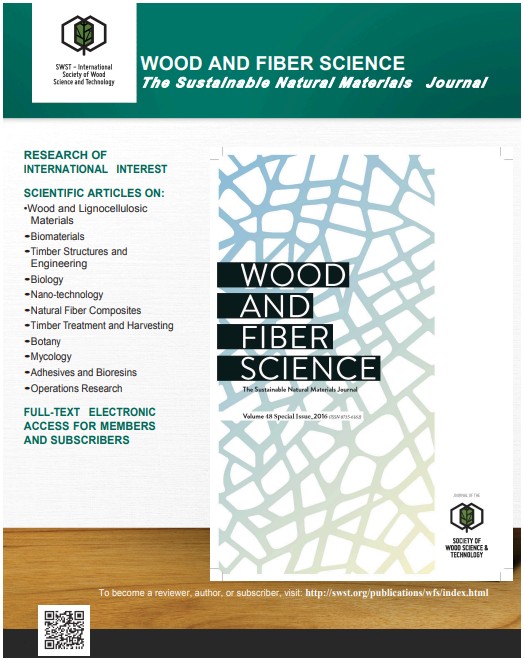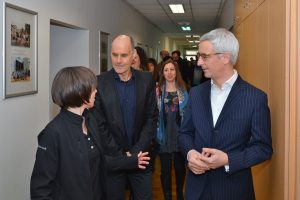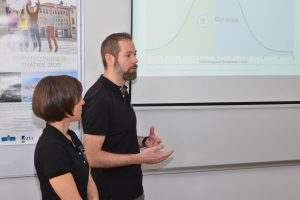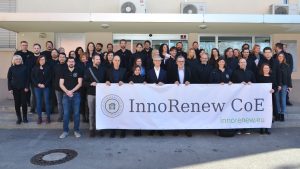
January 5, 2026

Koper, 15th February 2019
Since establishing the InnoRenew CoE research institute in 2017, we have committed to scientific work, creativity, innovation and cooperation with industry to become the world leader in the research area of renewable materials and sustainable buildings and in transferring our scientific knowledge into industrial practice.
The InnoRenew CoE was established on 15th February, two years ago. In collaboration with one of our main founders, the University of Primorska, we organized a ceremony that was attended by the InnoRenew CoE employees as well as the Minister of Education, Science and Sport Prof. Dr. Jernej Pikalo, Mayor of Izola Danilo Markočič, and Rector of the University of Primorska Prof. Dr. Dragan Marušič.

Dr. Andreja Kutnar, Prof. Dr. Dragan Marušič, Prof. Dr. Jernej Pikalo. Image: Alen Ježovnik
The event began with the welcoming speech of the director of the InnoRenew CoE, Dr Andreja Kutnar, who expressed great pleasure that the minister and other important guests responded to our invitation and joined us in the celebration. She is happy that we achieved and exceeded some established goals. In the past months, activities that marked our most important work were related to the construction of our new building. Architect and assistant researcher, Eva Prelovšek Niemelä, presented more precisely all past construction-related activities and plans for the InnoRenew CoE’s new building. Just one year ago, we signed the tripartite contract with the Municipality of Izola and the University of Primorska regarding the transfer of building rights on one part of the land in Livade, Izola, and in September we received the building permit. Currently, we are in the process of selecting the contractor of construction and supervision. On the land in Livade, we plan to have two wings. In the first one we will have cabinets, offices and laboratories, and in the second one we will have a composites manufacturing laboratory. The two wings on the ground floor are designed with concrete, and the other floors are designed with a massive wooden structure. With the exterior, the building will actively connect with the local environment. On the facades we will use local stone and wood, and the building will be surrounded by an attractive publicly accessible park with indigenous vegetation. The wooden facades will be used in a traditional way, as a shade, a traditional pergola-like structure and a vertical “latnik” to support growing the vines. The interior of the building will be shaped according to the principle of restorative and ergonomic design, which is one of the main research areas of our research institute. With the help of visible wooden surfaces, pleasant acoustics and lighting, we will provide a healthy and innovative working environment. The internal atrium, which will connect all above ground floors, will enable active communication and a sense of belonging among employees. The building is designed as a research project by researchers of the InnoRenew CoE; therefore, the building will be subject to constant monitoring, which will include observing the strength and durability of wood on the exterior and interior, numerous measurements of temperature and humidity transitions, identifying health-friendly solutions and ergonomics in workplaces.

Dr Andreja Kutnar and Dr Michael Burnard. Image: Alen Ježovnik
We continued the event with the overview of our research work, new projects and the five research groups of the InnoRenew CoE. First, Dr Michael Burnard presented the work of the Human Health in the Built Environment group: “The work of this group is leading towards a happier, healthier and more productive society by ensuring our buildings provide more than only the most basic needs and connect us more closely with the natural environment.”
Next, Dr Anna Sandak, the research group leader of the Wood Modification group, confirmed that their research and projects are encouraging greater use of under-utilised species, new ways of using wood and other renewable materials and advanced techniques to characterise materials and treatments.
In the Information and Computer Technologies group, led by Dr Miklós Krész, they are currently working on two of the InnoRenew CoE’s start-up projects and on five externally funded projects. They are focused on improving the digitalisation of the industrial and human environment related to renewable materials and sustainable buildings on the product and process levels.
The Sustainable Building with Renewable Materials research group is focused on systemic building design specific to timber construction. Dr Iztok Šušteršič and his team work to address critical challenges in the built environment, such as improving the overall sustainability of construction and buildings through the rational use of wood and other renewable materials, advancing engineering in timber buildings that allow the use of wood in tall buildings and creating adaptable spaces for a rapidly changing population.
Finally, Dr David DeVallance presented the research of the Renewable Material Composites group, emphasizing the main goal of the group is to advance innovations in renewable composites by developing value-added composites from under-valued and under-utilised biomass for use in high-performance applications.
For our second anniversary, the rector of the University of Primorska, Dr Dragan Marušič, expressed his satisfaction for the successful work of our team. Minister Dr Jernej Pikalo said: “We all strive to reach the international nature. This is the first time it was actually done, and in this sense I sincerely congratulate all of you.” He emphasized that our new building is necessary for our future development and the continued research work of our institute, and he hopes that together we will make it happen.

InnoRenew CoE with guests. Image: Alen Ježovnik
The event ended with refreshments and networking where we remembered our past successes. We have hired 47 experts from different areas of expertise and parts of the world, gained more than a million and half euros of additional funding with successful project applications, added to our Living Lab we more than 100 members and, with the organization and participation at international and national events, successfully placed our institute on the map of research institutes.
On this occasion, we would like to say thank you to our project partners for all their support: the University of Primorska, Fraunhofer WKI, the Slovenian National Building and Civil Engineering Institute, the Institute for the Protection of Cultural Heritage of Slovenia, the University of Maribor, the Pulp and Paper Institute, Zavod eOblak, the National Institute of Public Health, and the Regional Development Agency of the Ljubljana Urban Region (RRA LUR).